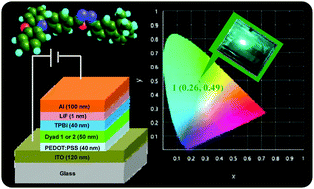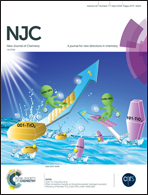Design and synthesis of solution processable green fluorescent D–π–A dyads for OLED applications†
Abstract
New solution processable organic donor–π–acceptor dyads 1 and 2 having electron donating phenoxazine and electron accepting oxadiazole groups have been synthesized. Intramolecular electron communication between the donor and acceptor moieties of these dyads was tuned through changing the substitution pattern at the phenylene linker. The photophysical properties of these dyads have been studied in the solution and film states. These dyads showed green fluorescence and exhibited a positive solvatochromism in the emission spectra, which indicates more polar excited states owing to an efficient charge migration from the donor phenoxazine to the acceptor oxadiazole moiety. The electrochemical, morphological and thermal properties were investigated through cyclic voltammetry, thermogravimetric and atomic force microscopy (AFM) analyses. To understand the electronic structure and band gap of these dyads, density functional theory (DFT) calculations have been performed. Furthermore, we have fabricated the solution processed un-doped electroluminescence devices based on these dyads, which exhibited efficient green emission with Commission Internationale de l’Eclairage (CIE) coordinates of (0.26, 0.49) and (0.27, 0.47) for 1 and 2, respectively, with a luminance maximum of ca. 1751 cd m−2 for the dyad 1, thereby demonstrating its use in organic light emitting diodes (OLEDS).



 Please wait while we load your content...
Please wait while we load your content...